The 2nd and 3rd grade RL.2.1 / RL.3.1 ask and answer questions in literature standards are closely aligned. Both standards require students to determine what the text says explicitly to understand the key details within the text. The only major difference between these two standards is that the 6 Ws are used as the types of questions in the 2nd-grade standard, whereas the 3rd-grade standard does not expressly refer to the 6 Ws. Ultimately, students in both grades should be able to ask and answer explicit questions. In this post, I walk through my strategies for teaching ask and answer questions skills. I also included a short video with my three quick tips for teaching asking and answering questions.
This chart will help you unpack this standard:
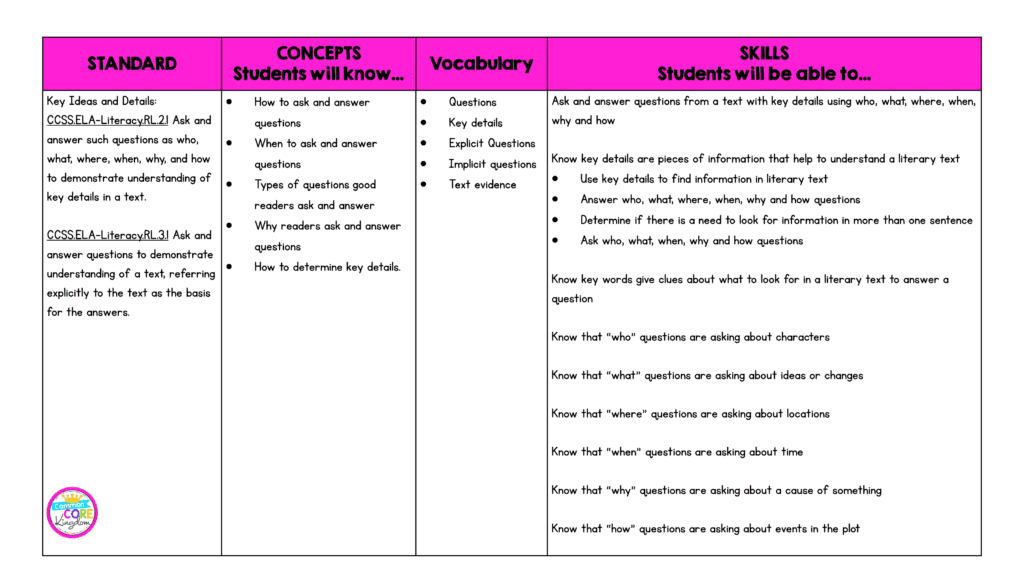
Since this is one of the most basic standards, I always teach Ask and Answer Questions at the very beginning of the year at a basic level. I then revisit this skill periodically throughout the year to reinforce student monitoring of their own comprehension.
During the first ask and answer questions in literature teaching cycle, focus on asking and answering questions before, during, and after reading.
Begin by modeling with mentor texts. I recommend the following picture books, but you can use any of your favorites.
Mae Among the Stars by Roda Ahmed
Nana Upstairs & Nana Downstairs by Tomie dePaola
It is important to have a balance of resources that include both real literature and passages. At the beginning of 2nd and 3rd grade, I tend to focus on using real literature to teach students to apply strategies to their independent reading. At the end of the year, I spend more time focusing on passages and comprehension questions. It is important for students to experience a variety of reading materials, and this is a great way to expose them to real literature by integrating it into a standards-based lesson. Doing so will help students understand that the standards they are learning should be applied to all reading materials, which will add practicality to the lessons.
1. Introduce the standard. Discuss the key vocabulary you will focus on during this ask and answer questions in literature unit.
2. Display the anchor chart and explain that readers ask themselves questions, then answer the questions to monitor their comprehension before they read, while they read, and after they read.
3. What happens if I cannot answer a question? This tells me I am probably not comprehending the text, so I will reread.
4. Select a read aloud to model asking and answering questions. If you would like the full lesson plans and sticky note questions for Mae Among the Stars by Roda Ahmed, you can grab my Mentor Standards unit on Asking and Answering Questions here. While reading, be sure to model going back into the text and rereading to find the answer to questions that are “right there.”
1. On day two, continue reading the same story, but have partners practice turning and talking to ask and answer questions.
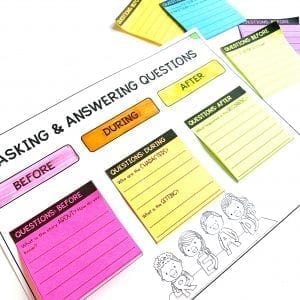
1. Once students have had ample time to watch you model and practice in partners, have students practice asking and answering questions in literature before, during, and after reading in their independent reading journals.
*Note: I recommend that independent reading is the largest block of time during reading workshop or centers. Students need this time to engage in literacy and work with text of their choice at their level. You can read more about why independent reading is so important in this blog post.
1. Each day after reader’s workshop is over, have everyone gather in your meeting spot with their journals and bag of books. Select about two students to share their independent reading practice. For this skill, students should share the book they read and one of the questions they asked and answered. They can also share any problems they came across. For example, if they were unable to answer their question, how they reread to find the answer.
2. Towards the end of the week, when students have had ample time to practice asking and answering questions, students rate how their independent reading work shows their mastery of the standard on a mini rubric in their journal. On the final day of the lesson, conduct very short conferences with each student to review their work and rubric and discuss next steps.
When I teach asking and answering questions at the beginning of the year, I leave the lessons to picture books and student chosen literature. I typically introduce asking and answering questions with passages when I revisit this standard the next time. If you are teaching this lesson at a later point in the year, you can introduce passages and literature simultaneously.
Depending on your curriculum calendar, you can do these next lessons immediately after week 1, or revisit later in the year.
During the second week of teaching, the focus of asking and answering questions in literature becomes using text evidence.
I recommend the mentor texts The Name Jar by Yangsook Choi and Nana Upstairs & Nana Downstairs by Tomie dePaola, but you can use any picture book of your choice.
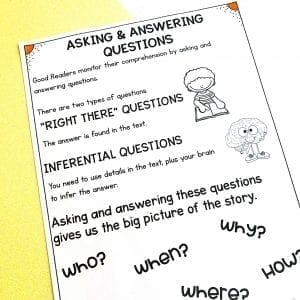
1. Display an anchor chart showing the different types of questions “who, what, when, where, why, and how”. Explain that:
1. Using the picture book, model stopping to ask and answer comprehension questions at various points throughout the book. Again, it is important to model what readers should do if they cannot answer a question.
1. After modeling a few questions and answers, stop at various points throughout the book and have partners practice turning and talking to share questions and answers.
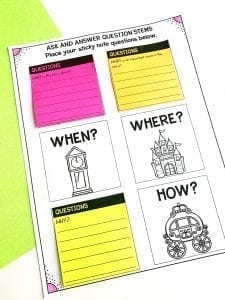
1. Send students off to practice the skill independently in their silent reading books. Students use sticky notes when they practice in their independent reading. I love using sticky notes because they are portable, and kids love them. After they write their questions, they place them in their journals for share time and for assessment.
1. Each day after reader’s workshop is over, select about two students to share their independent reading practice.
2. Before finishing this unit, have students rate their mastery on a mini rubric in their journal. Confer with students to review their progress and next steps.
If possible, I recommend you do passage and question practice immediately after week 2. It is important for students to see how the skills they learned the previous week transfer to passage reading; however, it is unrealistic to expect students to automatically translate the skills they learned without explicit instruction and guided practice.
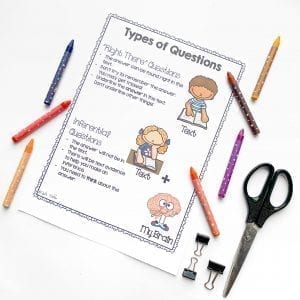
1. Open the lesson by showing students an anchor chart discussing the difference between “Right There” explicit questions and inferential questions. Tell students that today, you will model how to answer explicit and inferential questions.
2. Show students a one-page passage either blown up on chart paper, or on a projector. For more details on how I make my passages into posters, check out this blog post.
3. Model how to close read the sample passage. Read it through one time, stopping to think aloud about the topic. Then model answering a few questions. Be sure to think aloud about how to determine if the question is an explicit or inferential question.
4. Model how to underline the text evidence directly in the passage. I like to model using different colored crayons, colored pencils, or markers and have students do the same. This method is used in my 2nd & 3rd Grade Common Core Reading Passages.
1. Have students help you answer the remainder of the questions. For some questions use turn-and-talk or have students come up to underline text evidence on the poster.
Questions to Ask:
If your students need more support before working independently, you can have partners work on passage and question sets together on the following day. During this time, I would also pull a small group with my students who are reading well below level and work with them on a text they can have success with. For many of my ESE, ESOL, or intervention students I would use my first-grade passages.
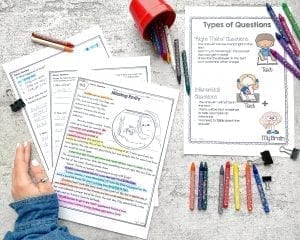
1. Students work on asking and answering questions in passages independently. I recommend scaffolding the passage levels you use.
2. For more scaffolding and differentiation tips, see my Teaching Reading Passages blog post here.
3. Students continue to practice reading passages for RL.2.1 until most of the class is showing mastery.
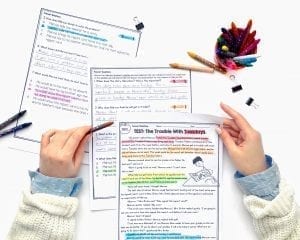
1. On the final day (typically at the end of the week), I administer an assessment for answering questions RL.2.1 & RL.3.1. You can find a Lexile leveled assessment to use in my questions product here.
2. The day after administering the assessment, I go over it with students. For more tips on reviewing and correcting assessments, visit my Teaching Reading Passages blog post here.
After you have thoroughly taught asking and answering questions in literature, it is important to continue to model and expect students to apply their skills to all reading, including read-alouds, independent reading, and guided reading. It is important skills aren’t taught in isolation. We want students to apply these skills and strategies throughout their daily lives to become stronger readers and thinkers. When reading literature, asking and answering questions is only one part of the puzzle.
These are the two products I featured in this blog post:
I also recommend my Ask & Answer Questions in Fiction Skills Pack! It is a bundle of my five top selling resources all focused on this important skill, and it even comes with a two week lesson plan!
Also, check out this quick video that walks through three easy steps for teaching asking and answering questions skills.
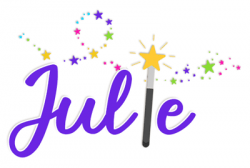
We strive to create resources that empower teachers and transform student success. We create skill-focused resources that promote critical thinking, enhance student engagement, and incorporate diversity. Our goal is to develop the tools teachers need to reach their students and foster a lifetime of learning.
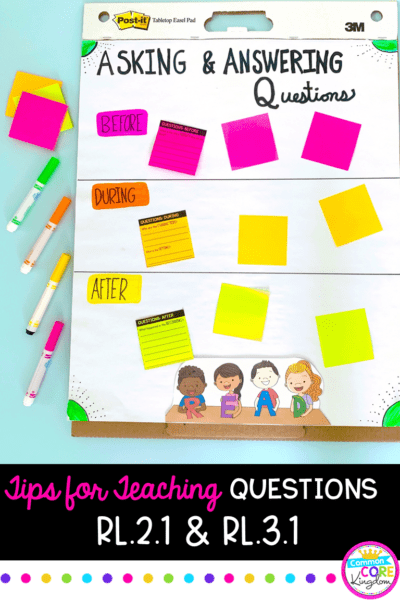
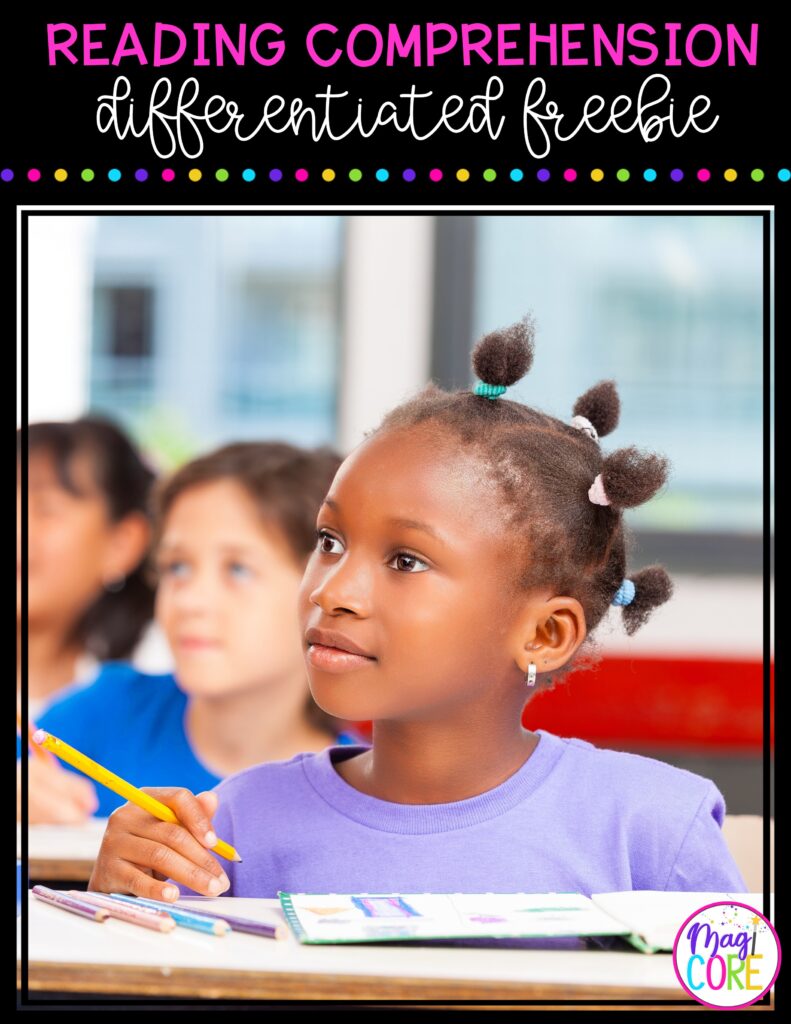
2 Responses
Wonderful tips and ideas! Thanks.
Your welcome, Malissa!